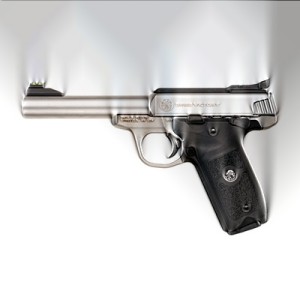 The Smith and Wesson SW22 Victory semi-automatic .22 LR pistol was not even on my gun ownership radar. Even if it were on my radar, buying a firearm the first year of its delivery to the market is not something I do; I like to wait until it has been evaluated publicly and any bugs worked out before I really consider one. However, I have been know to break my own rules (there are my rules, after all). While I had read some reviews on it, and viewed some on-line videos, I really did not take a serious note of it. It was just another semi-automatic .22 LR pistol to hit a market that had its fair share of Ruger semi-automatic .22 LR pistol owners. Aside from complaints about assembling MKIII and 22/45 pistols, which I also have a few, the Ruger line still dominates the competition. I think that the Smith and Wesson SW22 just might change all of that once folks really get to handle it.
The Smith and Wesson SW22 Victory semi-automatic .22 LR pistol was not even on my gun ownership radar. Even if it were on my radar, buying a firearm the first year of its delivery to the market is not something I do; I like to wait until it has been evaluated publicly and any bugs worked out before I really consider one. However, I have been know to break my own rules (there are my rules, after all). While I had read some reviews on it, and viewed some on-line videos, I really did not take a serious note of it. It was just another semi-automatic .22 LR pistol to hit a market that had its fair share of Ruger semi-automatic .22 LR pistol owners. Aside from complaints about assembling MKIII and 22/45 pistols, which I also have a few, the Ruger line still dominates the competition. I think that the Smith and Wesson SW22 just might change all of that once folks really get to handle it.
I was a little bored when I decided to visit my LGS and I was not looking for anything in particular, but I am always willing to have a look see at what’s under the counter. The LGS manager and I talked a bit, as we are acquaintances in a business sense with me having purchased several firearms from him. We were talking about new firearms in general when I mentioned the Smith and Wesson SW22 Victory – more out of curiosity about if he had handled one and what he thought about it. I sensed that I may be in trouble when, “I have one of those in the house.” came out of his mouth.
He had received two of the Smith and Wesson SW22 Victory pistols in the day before and sold one the same day. When I looked down into the glass showcase, I was immediately drawn to the pistol. It was familiar but different at the same time. But, before I get into that, let’s take a look at the basic features (according to Smith and Wesson) and go from there.
THE BASICS:
FINISH:
The satin stainless steel finish is one of the best that I have seen. While the frame seems to be of a rougher texture, the contrast between frame and barrel is very pleasing. The brushed stainless is contrasted well with the grip frame, grip panels, sights, and external controls.
MANUFACTURING:
The mating of barrel to receiver to frame is excellent. I could not find machining marks on anything external on the pistol or internal to the pistol. Laser etching is crisp and clear wherever it is applied. The SW22 is one good looking and well-made firearm, in my opinion.
The first thing (well, maybe the second thing) that you will notice when you pick the SW22 Victory up is the heft of the pistol. The SW22 Victory weighs in at 36-ounces unloaded (36.9 ounces loaded) with the majority of the weight being in the barrel and receiver and the stainless-steel frame contributing a lesser part of the weight.
All exposed edges are smooth and rounded or beveled in all o0f the right places; you won’t find any sharp edges to aggravate the hand. Overall, the SW22 Victory is a pleasing pistol to look at.
BOLT n’ BARREL:
The rear of the stainless- steel bolt contains serrations on the side for ease in pulling the bolt rearward. The serrations are rounded so as not to hurt the hand but textured enough to obtain a good grip on the rear of the bolt. The rear of the bolt has horizontal serrations that help cut glare and also add a nice contrast to the rear of the frame. The bolt, once removed from the pistol, can be dissembled for ease of cleaning all bolt components to include the firing pin and firing pin spring.
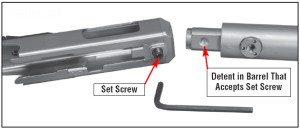 The 5.5” stainless-steel, target-crowned barrel is actually held in place by a single screw, which means that you can easily replace the barrel for another. Smith and Wesson has two accessory barrels for the SW22 aside from what comes with the pistol; a lightweight, carbon fiber 6-inch barrel from Volquartsen and a 6-inch stainless-steel match barrel with compensator that is also a Volquartsen product. Information on these barrels can be found in the SW22 Victory Accessories booklet that comes with the pistol or on-line at the Smith and Wesson site.
The 5.5” stainless-steel, target-crowned barrel is actually held in place by a single screw, which means that you can easily replace the barrel for another. Smith and Wesson has two accessory barrels for the SW22 aside from what comes with the pistol; a lightweight, carbon fiber 6-inch barrel from Volquartsen and a 6-inch stainless-steel match barrel with compensator that is also a Volquartsen product. Information on these barrels can be found in the SW22 Victory Accessories booklet that comes with the pistol or on-line at the Smith and Wesson site.
Aside from the obvious reason to remove the barrel to replace it with another, there is a not-so-obvious reason for removing the barrel. Haven’t you ever just wanted to clean a barrel without all that receiver in the way? Copper and lead fouling can really foul up a barrel. The SW22 Victory makes scrubbing a barrel easy when you really have a need to do so. with a properly-sized Torx-head tool, you can easily remove the barrel in a matter of seconds for judicious scrubbing of the internal lands and grooves, which also opens up the receiver for cleaning. Oh, my! A few turns and tightening of a single set screw and the barrel is back in place. Oh, my Martha I am getting tingly!
The barrel on my SW22 Victory is a standard “bull” barrel without suppressor threads, although that could be an option for me at some point. The feed ramp is not polished and the chamber is tight, which means that you cannot be shy when using the bolt release or the slingshot method when chambering a round.
SIGHTS:
A green fiber optic Williams Fire Sight front sight adorns the top of the barrel. The front sight can be easily removed and installed with an appropriate wrench.
The rear sight, also a Williams Fire Sight product, is a U-shape green fiber optic that is fully adjustable for elevation and windage. This was a stand-out and welcomed feature for me and was a strong selling point. The rear sight color is also a shade lighter than the front sight, which provides a good contrast between front and rear sights.
But wait! There’s more! Included with the SW22 is a polymer Picatinny rail (ooh!). Simply remove the existing rear sight (Torx wrench required, but not provided) and replace it with the Picatinny rail for mounting an optic. With the Picatinny rail, you do get a rear sight notch and it is just that – a rear sight notch with no outline, dots, or anything. Of course, the Picatinny rail’s sight is fixed.FRAME n’ GRIP:
The frame is stainless steel that blends excellently into a polymer grip frame. The grip frame has an excellent beaver-tail portion that blends into the frame itself, which in turn, allows you to get as high a purchase on the back-strap of the pistol as possible without worrying about slide bite.
The trigger guard is stylized, but provides adequate room for a gloved hand. The angle of the grip is as exaggerated as, say, a Ruger MKIII and is more reminiscent to that on a 1911 pistol in my opinion. The grip angle is such that you don’t feel like your hand is canted downward when you grip the pistol. The grip angle is ergonomically pleasant.
The front and rear of the grip frame are identically textured and provide a most positive grip on the pistol. The front-strap of the grip frame is undercut at the trigger housing to provide as much hand purchase as possible.
At the rear of the frame is a pinned, polymer buffer block that stops the rearward travel of the bolt. While I do not know the life expectancy of the buffer I suspect that it will last for more rounds than I will shoot through this pistol. The buffer also has a notch that prevent the guide rod from coming out of its resting place in the bolt.The rear of the grip frame is arched and seems to just melt in my hand. No accommodation for changing back-straps is made for different hand sizes. The grip panels can do that, but more on that in GRIP PANELS. The butt of the grip is rounded and conforms to the base of the hand well.
GRIP PANELS:
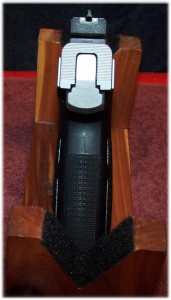 The grip panels, as is the grip frame, are polymer, but are also removable while being held in place by grip screws. The grip panels are smooth with the exception of where they need to be textured to provide a good purchase for palm and fingers. While the texturing is mild, there is more than enough textured area to provide for a good hand purchase.
The grip panels, as is the grip frame, are polymer, but are also removable while being held in place by grip screws. The grip panels are smooth with the exception of where they need to be textured to provide a good purchase for palm and fingers. While the texturing is mild, there is more than enough textured area to provide for a good hand purchase.
The grip panels are nicely rounded but relieved where they need to be to access the magazine release button, slide lock, and thumb safety. The grip panels are also relieved at the bottom so as not to interfere with inserting a magazine.
In my opinion, the combined grip frame and grip panels make for a very comfortable grip. Like a CZ75, this grip just feels at home in my hand and I have no intention of changing them. The SW22 Victory is, to me, just one of those pistols that you can pick up and it just feels right. I cannot say that about a lot of pistols. If a pistol (or any handgun for that matter) feels good, you are going to want to shoot it more often than not.
Even though the grip panels are of a good thickness, I still had to try to make them fit better in my hand. I happened to have a Hogue Handall Slip-on grip with finger grooves that I had used on another pistol and decided to see if they would work with the SW22 Victory. While not a perfect fit, the Hogue Handall Slip-on grip is adequate enough to slide over the SW22 Victory handle tightly and provided me with a hold that is perfect for my hand. The finger groves and palm swells of the Hogue Handall Slip-on grip are a plus (in my opinion) and I have become somewhat spoiled by them.SAFETIES:
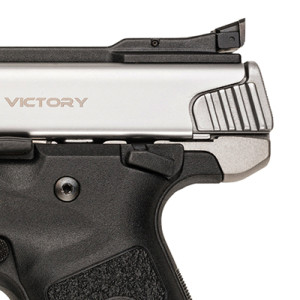 There are no integrated lock safeties akin to key locks found on many pistols and revolvers these days. I thank you Smith & Wesson for not including an internal key lock. While a key-lock is provided with the pistol, the key lock is of the cable type that can serve other purposes.
There are no integrated lock safeties akin to key locks found on many pistols and revolvers these days. I thank you Smith & Wesson for not including an internal key lock. While a key-lock is provided with the pistol, the key lock is of the cable type that can serve other purposes.
The SW22 Victory does have a left-side, polymer-covered metal, frame-mounted thumb safety that is not difficult to disengage with the thumb of the shooting hand but is rather stiff to engage into safe mode (up). Smith and Wesson, at least, stayed with convention with the direction of the safety; up for safe, down for fire. The top of the thumb safety lever is serrated for positive downward movement but is slightly awkward to move up into the safe position. You see, the thumb safety lever pivots at the front and not the rear as with a 1911 (and others) thumb safety. I have found; however, that I can use the knuckle of the thumb on my shooting hand to nudge the safety into the “safe” position without shuffling my grip to do so (too much anyway).
While I don’t consider the slide lock a safety, but in a sense it is. Obviously, the pistol cannot be fired with the bolt rearward. The bolt can be moved to the rear while the thumb safety is in the safe position (up) and locked back with the slide lock. The polymer-covered metal slide lock lever is slightly extended and provides a positive surface for releasing or locking the slide. The left-side grip panel is relieved at the slide lock to ensure positive slide lock operation in both directions. If you have small hands, the position of the slide lock with the shooting hand may be somewhat of a challenge. However, the slide lock is easily manipulated with the thumb of the “working hand”
TRIGGER:
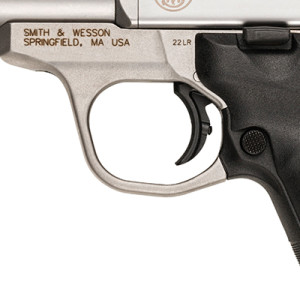 The trigger is, well, wonderful. New and out of the box, the trigger broke at just less than 3 pounds of pull. There is a very slight take-up and then a very crisp release. An over-travel adjustment is provided, but no adjustment is necessary (over-travel has been adjusted at the factory) but it’s nice to know that it is there.
The trigger is, well, wonderful. New and out of the box, the trigger broke at just less than 3 pounds of pull. There is a very slight take-up and then a very crisp release. An over-travel adjustment is provided, but no adjustment is necessary (over-travel has been adjusted at the factory) but it’s nice to know that it is there.
The trigger face is serrated and squared-off for a positive feeling trigger. I would say the inclusion of the the thumb safety into the pistol’s is due to this light trigger and I would recommend using the thumb safety any time a magazine is loaded and a round is chambered. Essentially, you have a 1911 in your hands. The trigger is better than a lot of 1911 pistols on the market and “Condition 1” should be exercised with the SW22 Victory. Perhaps, that’s why I feel at home with the pistol.
Now for the groans! The SW22 Victory does incorporate a magazine disconnect. Personally, a magazine disconnect does not bother me. While I will not recommend removing the magazine disconnect safety, it can be done and very easily so. The spring-loaded magazine disconnect safety is located on the right side of the pistol under the right grip panel and can be seen inside of the magazine well at the bottom. There is more on magazine disconnect safety in MAGAZINES.
Compared to the standard trigger on a Ruger product, there is nothing really to compare. Ruger has been bested in the standard trigger department.
MAGAZINES:
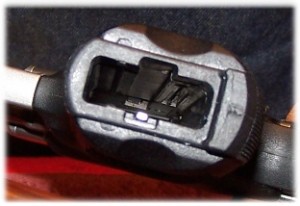 The SW22 Victory comes with two 10-round proprietary magazines. The magazines are steel with a polymer follower and incorporate a “pull-down’ button on the left side of the magazine to aid in loading.
The SW22 Victory comes with two 10-round proprietary magazines. The magazines are steel with a polymer follower and incorporate a “pull-down’ button on the left side of the magazine to aid in loading.
The base of the magazine has a protrusion that mates with the magazine disconnect safety when the magazine is inserted and locked into place. When you insert a magazine the protrusion engages the stem of the magazine disconnect safety and pushes it upward, which allows the pistol to fire (assuming that the thumb safety is in the Fire position).
The magazine release button is on the left side of the frame just behind the trigger guard. While not extended, the magazine release button is easily pressed and releases the magazine in a positive manner. It also locks the magazine in place just as positively. The grip panel is relieved lightly above the magazine release button, but also helps to prevent the button from being pressed inadvertently.
It is advised by Smith and Wesson that you do not slam a magazine into the pistol. Slamming a magazine into the magazine well could cause the bolt to slam forward on a live round.
DISASSEMBLY, LUBRICATION, n’ REASSEMBLY:
If you currently own a Ruger MKII, MKIII, or 22/45 you will love this part.
Disassembly:
Obviously, a safety check is conducted first prior to performing a disassembly of the pistol to ensure an empty pistol.
- With the provided hex-head wrench, turn the take-down screw, which is located just in front of the trigger guard, counter-clockwise to loosen and then remove the take-down screw.
- While holding the barrel and frame together with one hand, remove the take-down screw completely.
- Remove the barrel/receiver assembly from the frame by tipping the muzzle end up slightly and pulling the assembly forward, off the tabs at the rear that hold them together and away from the grip frame. Note: Once lifted clear of the frame, the bolt is free to slide out the rear of the receiver. Take care not to drop the bolt as this could dislodge the Guide Rod and Guide Rod spring from its detent in the bolt. The Guide Rod is under spring tension and could fly free from the pistol.
- Grasp the bolt at the serrated area and withdraw it from the receiver.
While the bolt can be further disassembled for cleaning, I am going to steer you to the Owner’s Manual for that information.
Lubrication:
 Lubricating the SW22 Victory is quite straight forward:
Lubricating the SW22 Victory is quite straight forward:
Apply a single drop of firearm lubricant to the points shown in the accompanying image. This will assure proper lubrication of your pistol. Do not over-lubricate. Excess lubricant can collect large quantities of un-burned powder and carbon residue, which could interfere with proper functioning of the pistol.
Assembly:
- Replace the bolt into the receiver.
- Replace the barrel and receiver onto the grip frame. Push rearward slightly against the spring tension, hook the receiver tabs into the notches in the frame and tip the barrel assembly down at the muzzle so the barrel lug goes into the recess in the frame.
- Replace the take-down screw and tighten it down snug with wrench provided.
Note: I have installed a Nitrile O-ring to help prevent the take-down screw from backing out under fire; an issue that has been reported by several users of the SW22 Victory pistol. Specifically, I used an O-ring with the following dimensions; 3.8mm ID x 7.6mm OD x 1.9mm Section. However, I understand that a #61 standard O-ring will also work. I prefer Nitrile O-rings because they are heat resistant. These O-rings are very inexpensive and can be purchased in bulk; I replace the O-ring, as part of my maintenance, when cleaning the pistol after every shooting session.
- Check for proper operation.
The ease of disassembly and assembly of the SW22 Victory alone makes it worth a try over the Ruger MKIII and 22/45, Browning Buckmark, etc.
While there is a tendency to dry-fire a firearm after assembly (or for practice) you may want to read DRY FIRING before doing so!
DRY-FIRING:
Important Note on Dry Firing: DO NOT DRYFIRE! Without a means to protect the firing pin and chamber face, dry firing is not recommended. Don’t use a plastic snap cap, as the force of the firing pin impacting a plastic snap-cap is enough to damage the plastic snap cap, and which could result in not being able to pull back the action if a piece of the snap-cap falls into the action and locks up the hammer movement.
Secondly, the hammer is under spring tension – a lot of spring tension. If the hammer falls forward on an empty chamber, you may find it almost impossible to move the bolt rearward due to the angle of the hammer against the bolt and the extreme spring tension that the hammer is under. This is especially true when the pistol is new, although the difficulty wanes after the pistol is properly broken in.
The bolt locking up could also occur during a misfire, and you are trying to clear the round from the chamber, and the bolt will simply not budge. The only answer is to use the provided take-down wrench and disassembly the pistol, remove the offending round by pulling the bolt rearward, cock the hammer, and then reassemble the pistol. Obviously, SAFETY IS FIRST AND FOREMOST – keep the muzzle pointed in a safe direction while disassembling the pistol with a live round in the chamber!
I advise that, once the pistol is assembled, you insert a chamber flag, close the bolt, and call it a day or simply flip the thumb safety on and remove the magazine to prevent the firing pin from impacting the breech face if you (by habit) pull the trigger (it is common to pull the trigger on a just-cleaned firearm and that is a hard habit to break).
RANGE TIME:
Note: Smith and Wesson recommends that the tightness of the takedown screw is checked periodically and tightened as necessary. I have read reviews on the SW22 Victory that mention the loosening of the take-down screw. For my part, I simply slipped a #61 Nitrile rubber O-ring over the takedown screw, tightened the screw, and called it a day. Nitrile is heat resistant and this should work fine for this application as not much heat is actually transferred to the take-down screw due to the heat-sinking qualities of the bull barrel. I plan to replace the O-ring at each cleaning.
I had a small assortment of ammunition from several manufactures for evaluation purposes:
- Federal AutoMatch 40-grain LRN (1200 fps)
- CCI Mini-Mag 36-grain CPHP (1260 fps)
- Armscor Precision 36-grain PHP (1260 fps)
- Blazer 40-grain LRN (1235)
While I do have some .22LR ammunition that will run in the 1300+ fps range, I reserve that ammunition for bolt-action long-guns and revolvers rather than beat up pistols with it.
For accuracy testing, I used a bench rest. I was concerned with groups, where rounds were impacting on the target, and ten rounds of each brand of ammunition were going to be sent to targets fifteen yards downrange. Initially, I used the Federal AutoMatch 40-grain (1200 fps) for the initial sight-in. That; however, was interrupted by the fact that the Federal AutoMatch 40-grain would not fully cycle the action. These were the first two rounds that I shot out of the pistol and I thought that I might just have a single-shot pistol on my hands, which I did not need.
I switched out ammunition to the Blazer 40-grain LRN (1235) and all 50-rounds ran perfectly. The rounds were impacting the target a little high and that was alright because most of my .22 ammunition if of the 36-grain weight.
Armscor Precision 36-grain PHP (1260 fps) ammunition (50-rounds) ran just fine and I lowered the rear sight about ¼-turn to get the POI to my POA. Advancing forward with the CCI Mini-Mag 36-grain CPHP (1260 fps) gave me the best group and took out the rest of the center of the bulls-eye.
With 150 rounds through the pistol, and feeling that the action had started breaking in, I returned to the Federal AutoMatch 40-grain LRN (1200 fps) and ten rounds of it ran fine.
I did discover a couple of things while running the SW22 Victory. One is that it needs to be run like a 1911 where you ride the thumb safety. I did, on several occasions, flip the safety up with the knuckle of my thumb. At first, I did not realize I was doing so and thought that I had a misfire or two. Once I realized that flipping the thumb safety up was happening, I started to ride the thumb safety and no further incidences with the thumb safety occurred. The second issue was that the pistol failed to lock back on the last round on two occasions. It was then that I realized that I was pressing against the slide stop. Unlike a 1911, where the magazine spring tension will usually override the thumb resting against the slide stop, the slide stop in the SW22 Victory is not under a lot of spring tension and cannot override the thumb resting against the slide stop. Keeping the thumb clear of the slide stop cured the issue.
Note that both issues were my fault in handling the pistol and not any fault of the pistol. These things you just learn and every firearm has its little foibles.
I experienced no backing out of the take-down screw; I believe that my Nitrile O-ring solution is working.
Once I was satisfied that the pistol was more accurate than I, I ran about one-hundred rounds slow and off-hand at the same 15-yard distance. Aside from difficulty in seeing the fiber optic sights in the range lighting, I was able to keep most of my shots where I wanted them. I found that, with the SW22 Victory, the trigger really likes the pad of the trigger finger rather than the first joint of my trigger finger as is done with most of my shooting. The light trigger is really nice after handling the trigger on the Ruger MKIII and 22/45.
Note that in outdoor lighting, the fiber optic sights really stand out and are excellent for me; the indoor range lighting plays havoc with my eyes and I have a hard time with even the best of sights – on any firearm.
The Hogue Handall slip-on grip with finger grooves worked really well and will probably remain on the pistol. I’ve really become spoiled with finger-groove grips.
SUMMARY:
 The Smith & Wesson SW22 Victory pistol is just one that once you have it in your hand you want to shoot it – a lot!
The Smith & Wesson SW22 Victory pistol is just one that once you have it in your hand you want to shoot it – a lot!
The SW22 Victory semi-automatic pistol was intended to address several gripes and complaints with other pistols of similar nature (Ruger, Browning) – ease of maintenance.
With standard features like the target-crowned bull barrel, an extremely nice trigger, and an excellent set of sights, the SW22 Victory is an excellent pistol for target or plinking, and with a few upgrades, a nail-driving competition pistol. With its frame-mounted thumb safety, the SW22 Victory could also serve as an inexpensive means to practice while performing a manual-of arms very similar to the 1911, which is my intention for the pistol.
The price of the pistol is within the realm of most people’s budgets. The SW22 Victory is not in the same class as the Smith and Wesson Model 41, but it sure is a pleasure to shoot. There are 3 models of the SW22 Victory, with mostly cosmetic differences: (1) Standard Victory, Model #108490, which has no threaded barrel with a MSRP of $409; The threaded barrel Model #10201 at a MSRP of$429; and a Kryptek Highlander Camo Model #10297 with a MSRP of$459.
While some may not like magazine disconnect safeties, in this particular case not having a magazine inserted prevents you from dry-firing the pistol and possible damaging the firing pin or peening the breech face as is known to happen on .22 caliber pistols and revolvers.
I’m sure that 3rd-party vendors are going to jump on the wagon and provide different grip panels, barrels, sights, and other options for this pistol should it be fully accepted by the shooting community – and I believe it will.
I’m afraid my Ruger 22/45 and MKIII are not going to see much use for quite a while.
Is the SW22 Victory a perfect pistol? In my opinion, the SW22 Victory is not a perfect pistol because it has enough foibles about it to keep it from being such; the loosening of the take-down screw during firing (easily corrected) and the possibility of the bolt locking up should you inadvertently dry-fire the pistol, are two major foibles in my book. With the first foible, the use of a correctly-sized Nitrite O-ring or a dab of purple thread-locker on the take-down screw will help to mitigate the take-down screw from backing out. For the second foible, simply using the provided chamber flag, setting the thumb safety to the “safe” position, or simply keeping the magazine out of the magazine well will prevent you from inadvertently dry-firing the pistol and this helps to mitigate the bolt lockup issue. But, even foibles have a positive side – they force you to take charge of the pistol, and being the responsible gun owner that you are, I’m sure that you will.
The extremely light trigger pull, in my opinion, takes the SW22 Victory out of the category of being a training pistol without an extensive amount of trigger pull sensitivity training beforehand. The SW22 Victory is, after all, touted as an entry-level target pistol and this pistol takes a trigger finger that is accustomed to a light trigger. For a training pistol, I prefer one with a slightly heavy trigger that forces the shooter to concentrate on maintaining a correct sight picture throughout the trigger pull. For an experienced shooter, one that is even moderately experienced, the SW22 Victory would be a fine pistol for plinking, practice, or competition. For my usage, the SW22 Victory will serve as an inexpensive substitution for my 1911 because the manual of arms for the SW22 Victory is very close to the 1911.
Over all, even with the minor nuances of the pistol, I am extremely pleased with it. If you are looking for a quality .22 semi-automatic pistol for whatever reason, the Smith & Wesson SW22 Victory might be worth considering.
DON’ Jus’ TAKE MY WORD FOR IT:
Note: The videos have more information on disassembly and assembly. Sometimes, pictures are better than words and I recommend the following:
- S&W 22 Victory Semi Auto Pistol Review: https://www.youtube.com/watch?v=BQIAgtGAgQM
- SMITH AND WESSON VICTORY REVIEW: https://www.youtube.com/watch?v=Ng-0FGrvBTg
- SW 22 Victory (HICKOCK45 review): https://www.youtube.com/watch?v=CHpiVLjawgg
- Smith & Wesson Victory .22 Pistol (Massad Ayoob): http://ontargetmagazine.com/2017/01/smith-wesson-victory-22-pistol/?utm_source=ontarget&utm_campaign=1-27-17&utm_medium=mailer
RESOURCES:
Smith and Wesson SW22 Victory: http://www.smith-wesson.com/webapp/wcs/stores/servlet/Category4_750001_750051_804153_-1_757752_757751_image
![]()


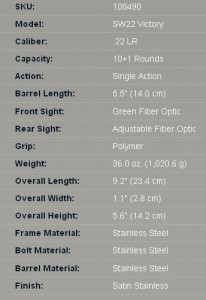
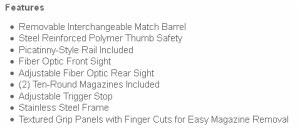

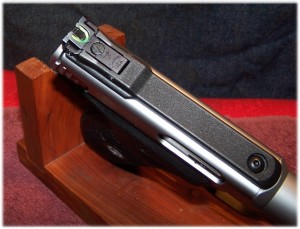
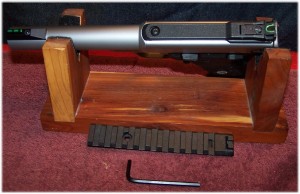

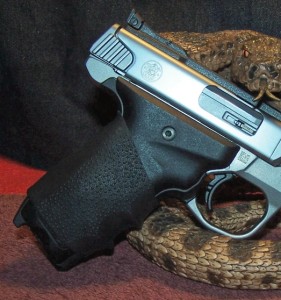
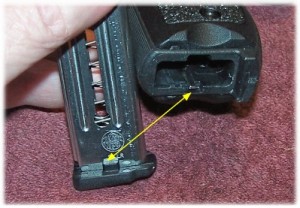

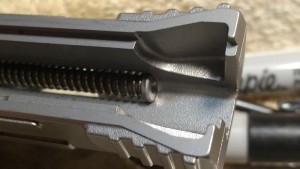

3 Responses to Smith and Wesson SW22 Victory Preventing Wear and Tear on the Ruger MK